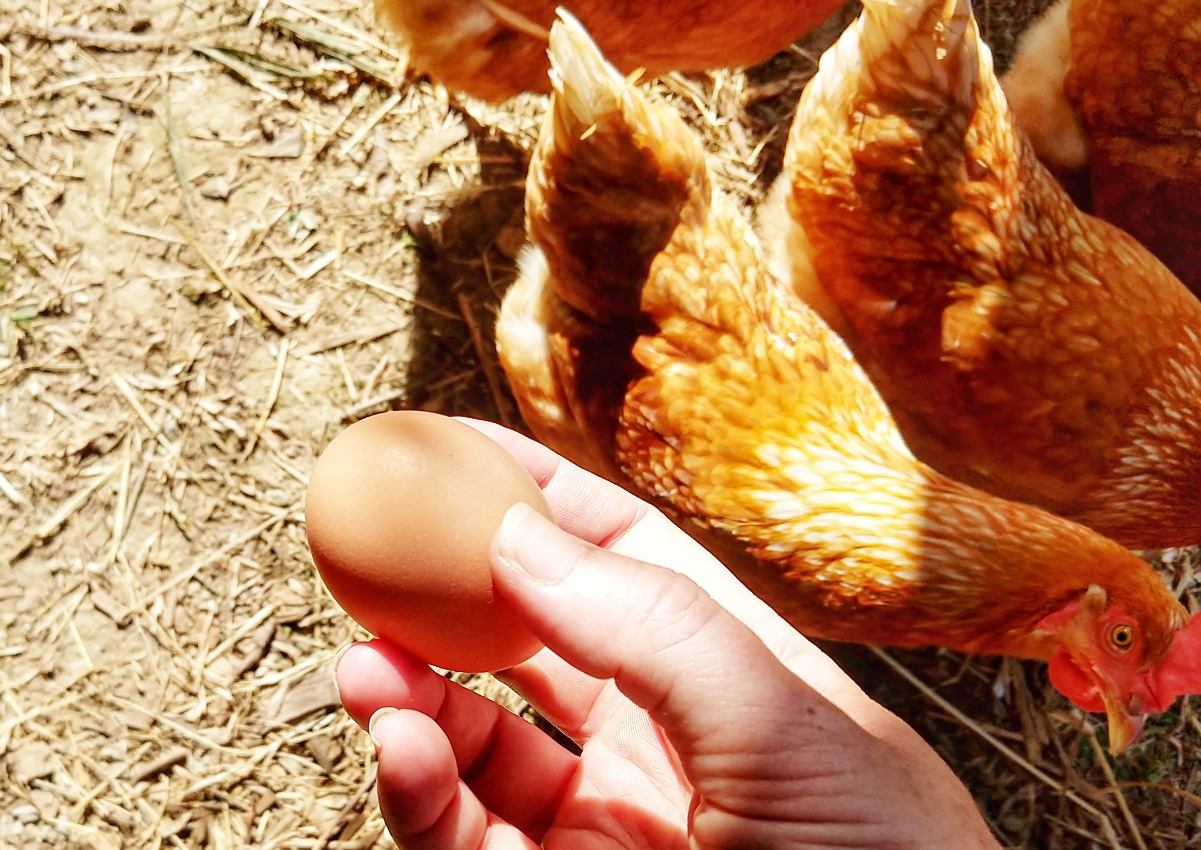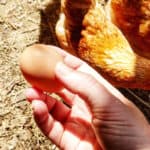This post may contain affiliate links.
Point of lay chickens are chickens that are just at the point at which they will start laying eggs. You’ll often see chickens advertised for sale as being at “point of lay” and this is a good time to buy chickens, you should get eggs from these birds within days or weeks.
Of course, nobody can guarantee exactly when chickens will lay their first eggs, but in general, good laying chickens start to lay eggs at 16 weeks old. This will vary with the breed of chicken, the weather, and their food. As a rule of thumb, 16 -20 weeks or about 5 months, is when chickens usually start to lay eggs.
Point of Lay

Disadvantages of Buying Point of Lay Chickens v Chicks
- Point of lay chickens will be considerably more expensive than newly hatched chicks.
- You don’t know how the poulet has been treated and raised, you won’t know what feed they have been on, you may not know about any previous medications or vaccines.
Expect to pay a few dollars for new chicks and $20-$30 for a point of lay hen. Special breeds and silkies will be more expensive.
Advantages of Buying Point of Lay Chickens v Chicks
Chicks are cute, but should you buy chicks, or point of lay hens?

- Newly hatched chicks require heat and special food. Point of lay chickens should be fully feathered and won’t require additional heat.
- Newly hatched baby chicks may be unsexed, half of your chicks could be roosters, point of lay hens should clearly be female.
- Raising chicks to point of lay takes time (16-20 weeks) and months of extra feed expenses.
- Mortality is higher in newly hatched chicks than in point of lay chickens
- Chicks and point of lay birds require different housing. To raise your own birds to point of lay you will need multiple stages of chicken coop or brooder, adding to costs.
- You will be eating your own eggs much faster if you buy point of lay hens.
Good laying hens generally lay 1 egg per day, roughly. They may stop laying in winter or when they are moulting. They may stop laying if they aren’t getting good levels of protein in their diets.
Some special of chickens, for instance, silkies, only lay about 5 eggs per week.
Chickens can even stop laying in winter in the tropics, or lay somewhat erratically in the winter months.
We have done it both ways. We’ve bought pullets just weeks from point of lay, and raised chicks bought at 3 days old. Buying point of lay hens is much, much easier. We recommend, if you are new to keeping chickens, start with a few birds at point of lay. If you then find that you love keeping chickens, add to your flock, either buy buying fertile eggs, buying a rooster (if local regulations allow) and breeding your own birds, or buy buying you chicks, online, at feedstores, on Gumtree, or at farmers’ markets.
What Equipment Do I Need For Point of Lay Chickens?

You will need a safe, secure home for them that is snake-proof, rodent-proof, and predator-proof. They need a place to roost at night, a perch, plus a nesting box in which to lay.
You will need to provide fresh clean drinking water. We highly recommend stainless steel poultry waterers over plastic.
It is possible to keep chickens without providing additional food, if you have plenty of land for them to free range, and abundant plants and animals for them to eat. Chickens will eat tiny mammals, amphibians, reptiles and invertebrates.
They will also scratch up your gardens and create dust baths, it’s important to chicken-proof your garden. Your chickens will eat some of your herbs, a lot of tropical food plants, and most fruit.
If the chickens can’t make a natural dust bath you’ll need to provide them with one using something like a cat littler box, ash, sand, and soil.
Chickens also need to eat grit, you can buy this if there is no natural grit in your coop.
- Buy a coop here
- Buy a stainless steel water dispenser here
- Buy layer feed here
- Buy oyster shell for laying chickens here
They are not fans of citrus, so our grapefruit, oranges, lemons and limes are pretty safe from chickens. They also don’t like spiky pineapple plants or lemongrass so you can use plantings like these to keep chickens away from your beds.
Chicken Terms to Know
- Pullet, a young female chicken less than 12 months old.
- Hen, a female chicken.
- Cockerel, a young rooster, under 1 year old.
- Straight Run chicks, mixed male and female chicks, unsexed.
- Point of lay chicken or pullet, a female bird about 5 months old.
Chicken keeping can be a wonderful hobby and over the months and years, you are likely to invest quite a lot of money in chicken keeping and raising equipment.
Having fresh eggs daily, and the joy your chickens bring is absolutely worth it. A flock of mixed birds is an investment, it is food security, it is insurance against times of trouble.
Here at Tropical Food Garden we keep mixed chickens, including beautiful pure-bred silkies, geese, and guinea fowl. Most birds can be bought at the point of lay, which occurs at different ages for each bird. Some egg laying chickens also make good meat birds but others, bred purely for egg production, aren’t great to eat.
Back to our main post on keeping chickens (and other poultry) in the tropics.








